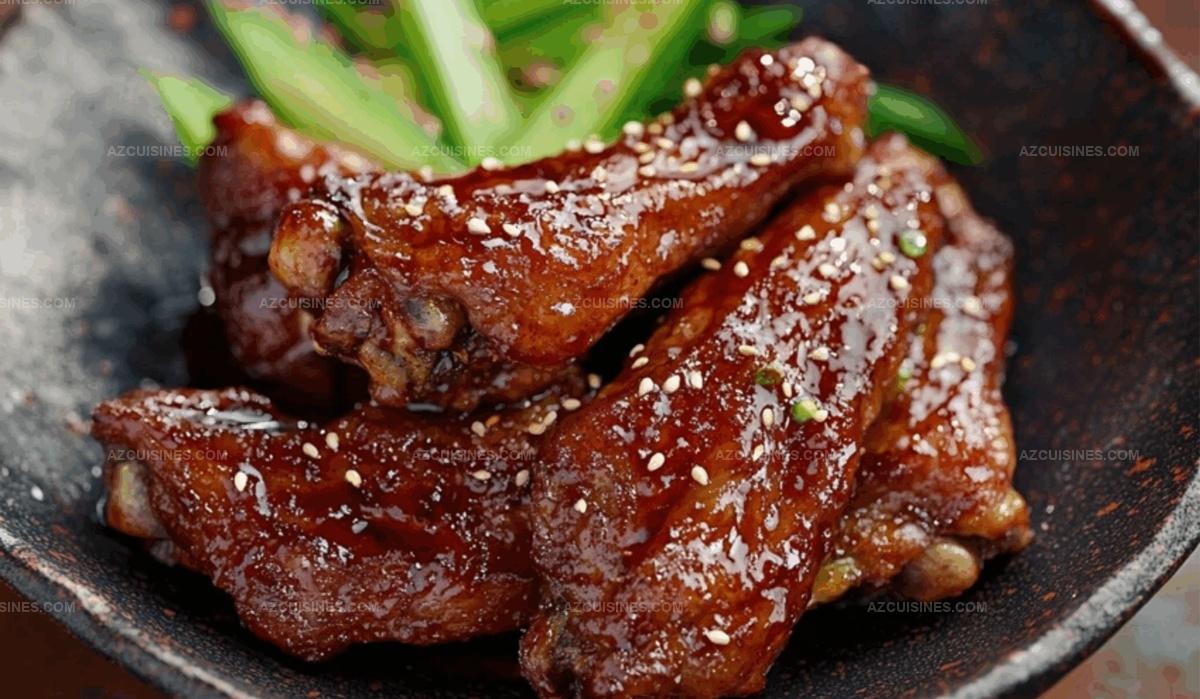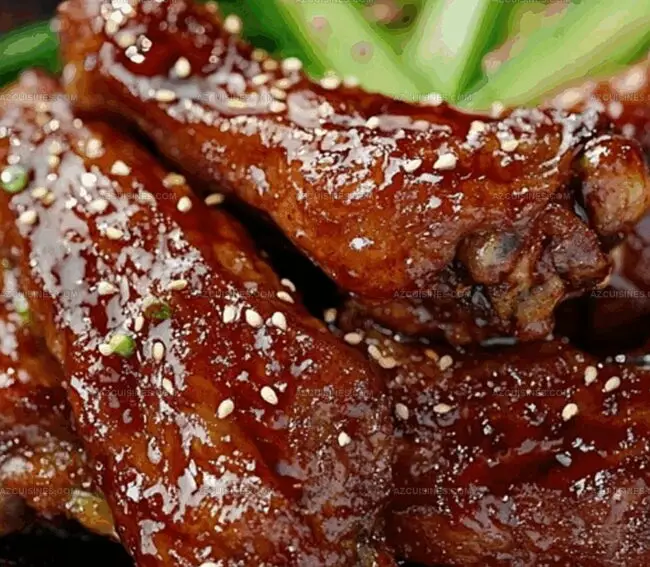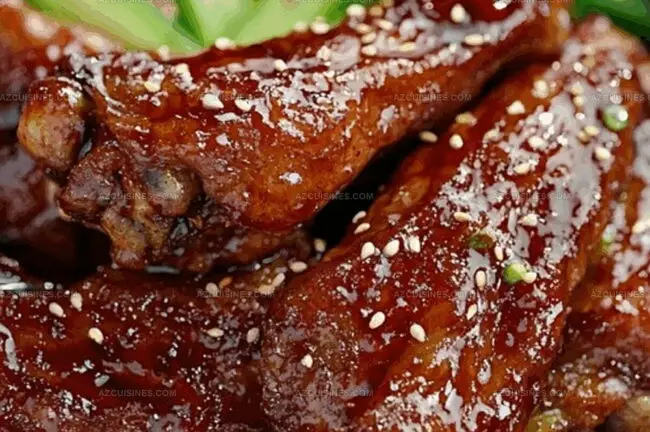The Zesty Tebasaki Chicken Wings Recipe You’ll Crave Forever
Crispy tebasaki chicken wings emerge as a delectable Japanese street food sensation that captures culinary imagination.
Osaka’s vibrant food culture birthed these mouthwatering delights decades ago.
Chefs in Japan perfected a unique seasoning technique that distinguishes these wings from ordinary preparations.
Salt, pepper, and subtle spices create an irresistible flavor profile that makes taste buds dance.
Marinating transforms ordinary chicken into a crispy, golden masterpiece with intense umami notes.
Restaurants across Japan celebrate this simple yet sophisticated dish that requires minimal ingredients.
You’ll want to bookmark this recipe and impress everyone at your next gathering with these incredible wings.
What Makes Tebasaki Chicken Wings a Must-Try
Tebasaki Chicken Wings Ingredient List
Protein:Marinade Ingredients:Coating and Cooking Ingredients:Garnish:How to Cook Tebasaki Chicken Wings the Easy Way
Step 1: Prepare Chicken Wings
Pat each chicken wing thoroughly with paper towels until completely dry. This crucial step ensures an ultra-crispy exterior that will make your wings irresistible.
Step 2: Create Flavor-Packed Marinade
Combine the following ingredients in a mixing bowl:Whisk everything together until the sugar dissolves and the marinade looks smooth and glossy.
Step 3: Marinate the Wings
Submerge chicken wings completely in the marinade. Cover and let them rest in the refrigerator for 30 minutes, allowing the flavors to deeply penetrate the meat.
Step 4: Coat with Crispy Powder
Remove wings from marinade and drain excess liquid. Generously coat each wing with potato starch, shaking off any clumps to create an even, light dusting.
Step 5: Prepare Frying Station
Heat vegetable oil in a large skillet until it reaches 350°F. Use a cooking thermometer to ensure precise temperature for perfect frying.
Step 6: Fry to Golden Perfection
Carefully lower wings into hot oil, making sure not to overcrowd the pan. Fry for 5-6 minutes, turning occasionally to achieve an even golden-brown color.
Step 7: Drain and Rest
Transfer fried wings to a wire rack or paper towels to remove excess oil. This helps maintain their delightful crispiness.
Step 8: Garnish and Serve
Arrange wings on a serving plate. Sprinkle generously with white sesame seeds and freshly chopped green onions. Serve immediately while hot and crunchy.
Tips to Get Crispy Tebasaki Chicken Wings
Tasty Variations for Tebasaki Chicken Wings
Best Pairings for Tebasaki Chicken Wings
How to Store Tebasaki Chicken Wings Properly
Your Tebasaki Chicken Wings Questions Answered
Potato starch creates an extra crispy, light exterior that’s crunchier than regular flour, ensuring wings have a delicate, golden-brown texture that’s signature to Japanese-style fried chicken.
Yes, you can replace mirin with a mix of rice vinegar and sugar, or use a small amount of white wine with a pinch of sugar to mimic the sweet, tangy flavor profile.
Use a meat thermometer to ensure internal temperature reaches 165°F, guaranteeing the chicken is safely cooked through without drying out the meat.
Print
Tebasaki Chicken Wings Recipe
- Total Time: 36 minutes
- Yield: 4 1x
Description
Spicy Japanese Tebasaki chicken wings bring Nagoya’s street-food magic straight to home kitchens. Crispy, perfectly seasoned wings deliver a bold flavor profile that connects diners with authentic Japanese culinary traditions you can savor in each delicious bite.
Ingredients
Chicken
- 2 lbs chicken wings
- 1 tsp salt
Seasoning
- 2 tbsp soy sauce
- 1 tbsp mirin
- 1 tbsp sake
- 1 tbsp sugar
- 1 tsp ginger, minced
- 2 cloves garlic, minced
Coating and Garnish
- 1/2 cup potato starch
- 2 tbsp vegetable oil
- 1 tbsp white sesame seeds
- 2 green onions, chopped
Instructions
- Pat chicken wings completely dry using paper towels to ensure crispy exterior.
- Blend soy sauce, mirin, sake, sugar, minced ginger, and garlic into a harmonious marinade.
- Submerge chicken wings in marinade, refrigerate for 30 minutes to infuse flavors.
- Drain excess marinade and thoroughly coat wings with potato starch, shaking off any surplus.
- Heat vegetable oil in a large skillet to 350°F, creating an ideal frying environment.
- Carefully place wings in hot oil, avoiding overcrowding, and fry for 5-6 minutes until golden brown and crispy.
- Flip wings midway through cooking to ensure even, uniform browning on all surfaces.
- Transfer fried wings to a wire rack or paper towels to drain excess oil and maintain crispiness.
- Arrange wings on serving plate and sprinkle with white sesame seeds and freshly chopped green onions.
- Serve immediately while wings are hot and at peak crispiness for maximum flavor enjoyment.
Notes
- Ensure wings are bone-dry before coating to achieve the ultimate crispy exterior that shatters with each bite.
- Use potato starch instead of regular flour for an extra light, airy, and crunchier coating that elevates the wing’s texture.
- Maintain consistent oil temperature around 350°F to prevent greasy wings and guarantee a perfect golden-brown finish.
- Experiment with marinade by adding gochujang or chili flakes for a spicy kick, making the dish more versatile and exciting for heat lovers.
- Prep Time: 30 minutes
- Cook Time: 6 minutes
- Category: Dinner, Appetizer, Snacks
- Method: Frying
- Cuisine: Japanese
Nutrition
- Serving Size: 4
- Calories: 480
- Sugar: 2 g
- Sodium: 600 mg
- Fat: 28 g
- Saturated Fat: 4 g
- Unsaturated Fat: 22 g
- Trans Fat: 0 g
- Carbohydrates: 24 g
- Fiber: 1 g
- Protein: 28 g
- Cholesterol: 100 mg




Truc Tran (Kris)
Senior Food Editor
Expertise
Home Cooking, Meal Planning, Recipe Development, Baking and Pastry, Food Editor, Cooking-video Maker, Vietnamese Food Evaluation Expert
Education
Truc Tran (Kris), an experienced food writer and editor, is great at exploring and describing global cuisines, from simple street food to fancy dining. In her writing, she skillfully mixes different flavors, cooking methods, and culinary traditions, showing the unique character of various cultures through their food and drinks. On azcuisines.com, Kris highlights her knowledge, especially in Asian cuisine and worldwide traditional dishes.